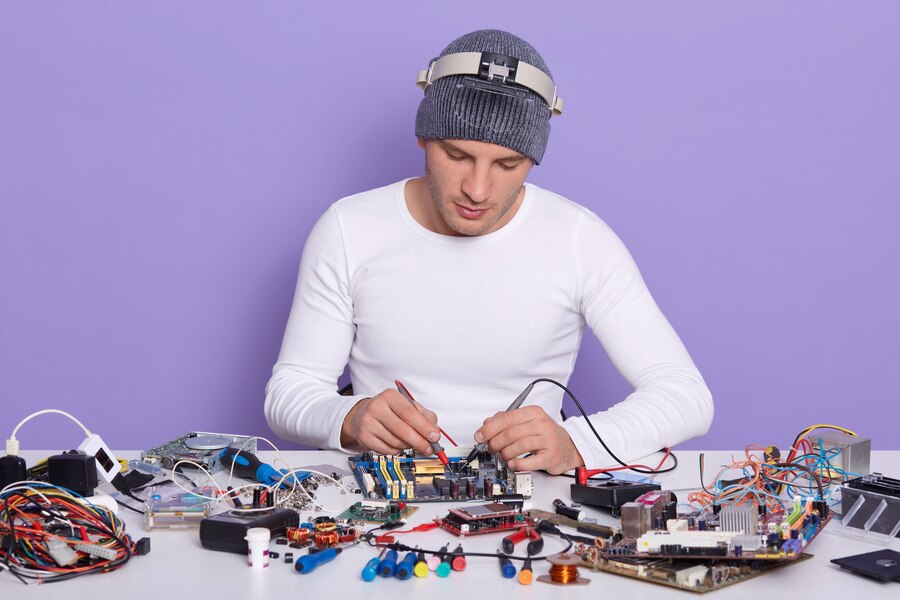Introduction
Entering the world of electronics can feel overwhelming with the sheer number of components available. However, by understanding a few basic components, beginners can build a strong foundation for tackling various electronic projects. This guide explores the top 10 essential electronic components for beginners, along with practical tips on how to use each one effectively.
1. Resistors
Resistors are among the most fundamental components in electronics. They limit the flow of electrical current, protecting sensitive parts of a circuit from damage.
- Symbol: Represented by a zig-zag line in circuit diagrams.
- How to Use: Determine the required resistance by using the color-coded bands or by consulting the resistor’s datasheet. For beginners, an online resistor calculator can simplify this process. Place resistors in series or parallel to achieve different resistance values in circuits.
2. Capacitors
Capacitors store and release electrical energy, making them essential for smooth power flow in circuits. They are often used to filter out fluctuations in power supply and store charge temporarily.
- Symbol: Two parallel lines, one straight and one curved.
- How to Use: Pay attention to capacitor polarity (for electrolytic capacitors), as connecting them incorrectly can cause malfunction. Place them near power sources in your circuits to stabilize voltage levels.
3. Diodes
Diodes are components that allow current to flow in only one direction, protecting circuits from potential damage caused by reverse currents. LEDs (Light Emitting Diodes) are a popular type of diode that emits light when current flows through.
- Symbol: A triangle pointing to a line.
- How to Use: Ensure correct polarity by identifying the anode (positive) and cathode (negative) sides. Diodes are often used in circuits to prevent the backflow of current and in power supplies to convert AC to DC.
4. Transistors
Transistors are key components in amplifying or switching electronic signals. They are essential for building amplifiers and can also act as small switches.
- Symbol: A circle with three leads: collector, base, and emitter.
- How to Use: Familiarize yourself with the transistor type (NPN or PNP) and use the correct pins when connecting to a circuit. Beginners can experiment by using transistors to control LED brightness or motor speeds.
5. Inductors
Inductors store energy in a magnetic field when electrical current flows through them. They are mainly used in power supplies and for filtering signals.
- Symbol: A coiled wire in diagrams.
- How to Use: Connect inductors in circuits with capacitors to create filters or in power supply circuits for smoothing. Their role in energy storage helps stabilize current flow, making them crucial in circuits that involve AC signals.
6. Relays
Relays are electrically operated switches that use an electromagnet to control the opening or closing of a circuit. They are useful for controlling high-power circuits with low-power signals.
- Symbol: A switch symbol with a coil nearby.
- How to Use: Connect the relay coil to a low-voltage circuit, which will activate a switch that can control high-voltage devices. Beginners often use relays to control multiple devices or for home automation projects.
7. Potentiometers
Potentiometers are adjustable resistors commonly used to control voltage. They are ideal for applications where adjustable settings, like volume control, are needed.
- Symbol: A resistor with an arrow across it.
- How to Use: Connect potentiometers in circuits where you need to vary the resistance and, consequently, the output signal. For instance, use them in simple LED dimmer circuits or to control audio signals in a speaker system.
8. Switches
Switches are used to make or break circuits, allowing you to control the flow of electricity. They come in various forms, such as push-button, toggle, and rotary switches.
- Symbol: A gap with a line that can connect or disconnect it.
- How to Use: Place switches at the start of circuits to control power. Experiment with different types of switches to create on/off controls or integrate them into more complex devices like alarms or DIY home automation.
9. Integrated Circuits (ICs)
Integrated Circuits are miniature circuits embedded on a semiconductor chip, performing various functions. Common ICs include timers, counters, and amplifiers, such as the popular 555 Timer IC.
- Symbol: A rectangle with multiple pins.
- How to Use: Follow the datasheet for proper pin connections. For beginners, try using a 555 timer IC in a basic LED flashing circuit, a project that helps illustrate the timing function of ICs.
10. LEDs (Light Emitting Diodes)
LEDs are popular components in beginner projects because they provide immediate visual feedback when a circuit is complete. LEDs come in various colors and sizes, making them ideal for indicators.
- Symbol: A diode symbol with arrows pointing outward.
- How to Use: Connect LEDs with a current-limiting resistor to avoid burning them out. Experiment with using LEDs as power indicators in circuits or even in larger displays by connecting them in series or parallel.
Conclusion
For beginners, mastering these ten essential electronic components opens the door to building and understanding countless circuits. Each component plays a unique role, and learning to use them effectively will help you progress from simple projects to more complex designs. Start experimenting with each component in isolation, and then combine them to create circuits that bring your electronic ideas to life!
